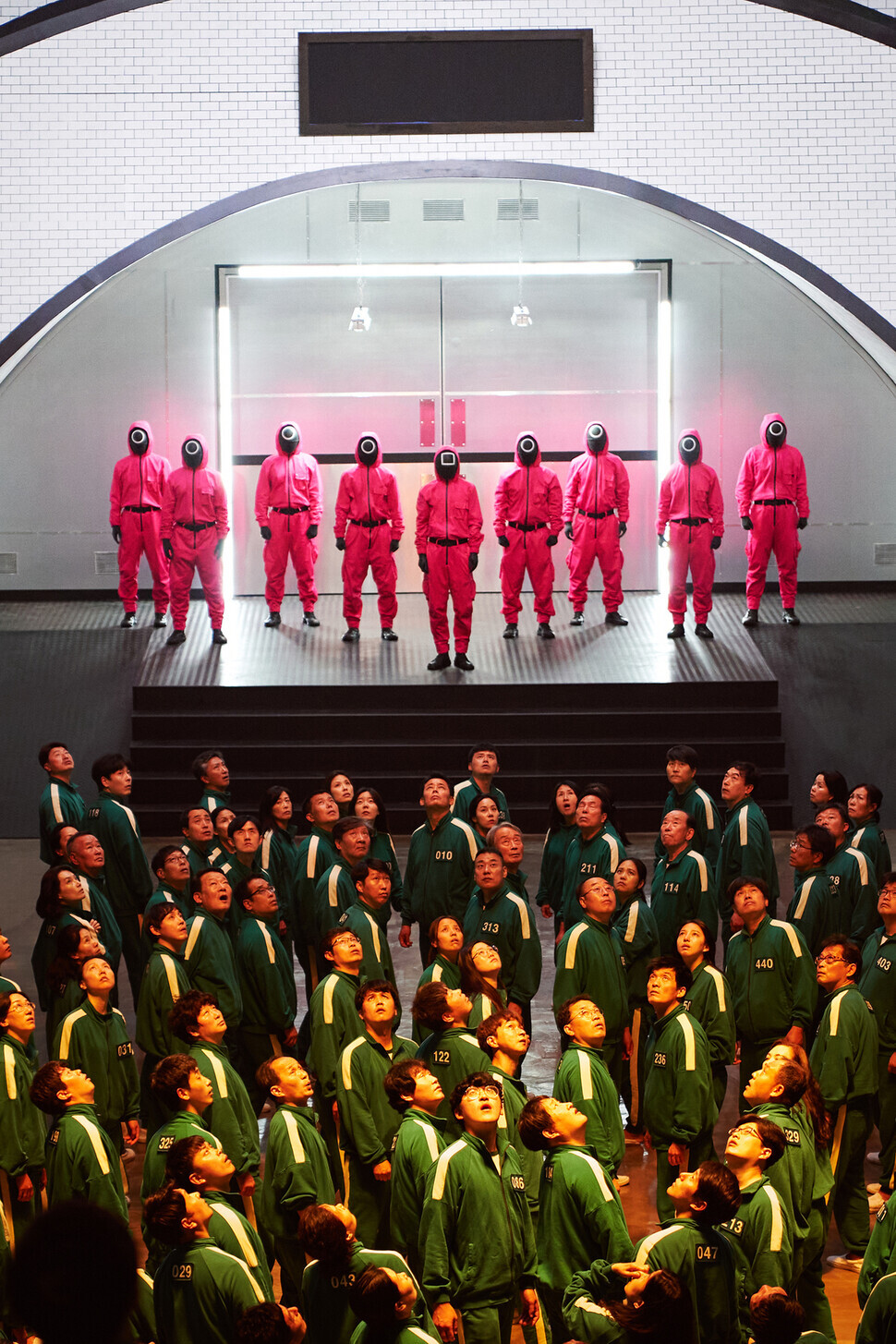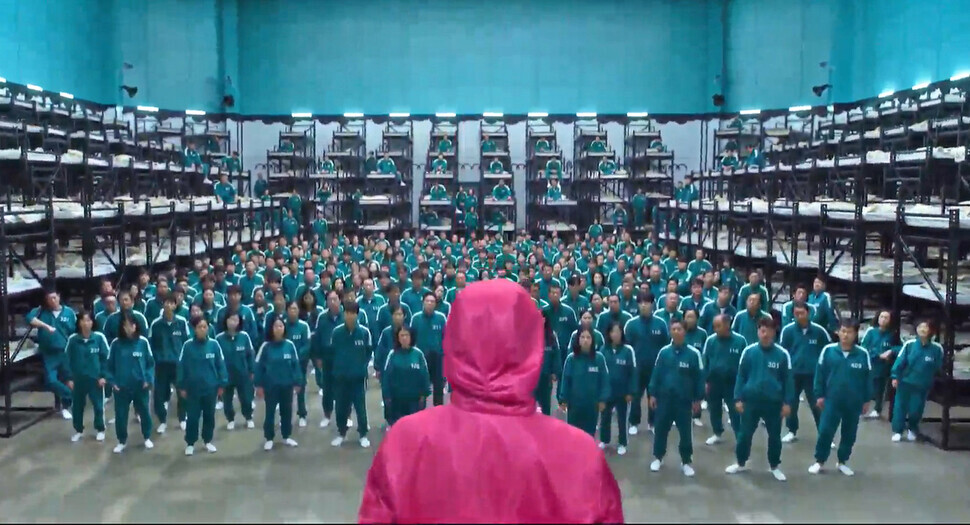hankyoreh
Links to other country sites 다른 나라 사이트 링크
Unraveling the global phenomenon of “Squid Game”

Giving his opinion on the box office outlook for “Squid Game” 10 days after it was released, Ted Sarandos, Netflix co-CEO and chief content officer, said, “’Squid Game’ will definitely be our biggest non-English language show in the world,” adding that there’s “a good chance it’s going to be our biggest show ever.”
His predictions proved to be true, as the Korean-style life-or-death game series, which debuted Sept. 17, has become a global sensation in the course of just 20 days. A look at the figures for the show reveals that calling it a “global sensation” is hardly a nationalistic overstatement.
According to FlixPatrol, an international online streaming ranking site, “Squid Game” ranked No. 1 at least once in all 83 countries Netflix officially services. Since the inception of Netflix, this is the first time any film or TV series has captured the No. 1 spot in all its countries. Fortune magazine has written that the show will exceed 80 million viewers.
After the release of “Squid Game,” which cost 20 billion won (US$16.7 million) to produce, Netflix’s stock rose by 12 trillion won (US$10 billion). Media reports noted a sudden spike in traffic on Google for people searching for the value of 45.6 million won and 45.6 billion — figures repeated throughout the TV series — in terms of their own country’s currency. On Oct. 7, four of the show’s principal actors, including Lee Jung-jae who played the protagonist Seong Gi-hun, appeared virtually on the popular US talk show The Tonight Show Starring Jimmy Fallon.
Rotten Tomatoes, the world’s largest film review site, posted a “Tomatometer” ranking of 94% for the show on Oct. 7, setting a record for having scored over 90% for three consecutive weeks. The site’s “critics consensus” comprising the views of 33 reviewers states: “Squid Game’s unflinching brutality is not for the faint of heart, but sharp social commentary and a surprisingly tender core will keep viewers glued to the screen – even if it’s while watching between their fingers.”

Koreans who were children in the 1970s and 1980s are likely to have played the titular “squid game” at some point. The names and rules differ slightly depending on where you call home, but they all share the same squid-like shape of the playing field.
A circle measuring about a meter across is drawn on the ground next to a triangle and rectangle that are about three to four times bigger. The players fight both within and outside of those shapes.
Those on offense begin at the part known as the “swimtong” — the circular space that connects with the tip of the squid’s head. They grapple with the opposing team, passing through the squid’s “body”; whichever side can make it to the “manse tong” section and shout, “Manse!” — or as Netflix translates it, “Victory!” — is the winner.
It’s a rough-and-tumble battle, wherein survival hinges on physical condition and athletic ability. It’s also much like the harsh world of adults, where only the fittest survive.
Director and scriptwriter Hwang Dong-hyuk explained, “I picked ‘squid game’ for the title because it was the game that best symbolized the competitiveness of modern society.”
The storyline of the “Squid Game” series is relatively simple. Seong Gi-hun (played by Lee Jung-jae) is a former employee of the fictional automaker Dragon Motors who was laid off after taking part in a strike against corporate restructuring. Hwang said he “borrowed the motif of workers at the time of the Ssangyong Motor labor dispute, where state authorities brutally suppressed the workers.”
Gi-hun opened a fried chicken restaurant and worked as a chauffeur, but met with little success. Sixteen years after he was laid off from his job at the auto manufacturer, he still suffers from post-traumatic stress disorder from the shock he suffered during the strike.

Now a divorced gambler who bets at racetracks and is hounded by collectors, he becomes involved in a bizarre game that promises the opportunity to win a fortune. There are 456 participants, and whoever manages to stay alive through six different survival games walks away with a prize of 45.6 billion won (US$38 million).
The first five death games are “red light, green light,” operating on sugar honeycomb (dalgona) cookies with needles, tug-of-war, marbles, and steppingstones. They’re followed by the eponymous squid game to decide the winner.
They’re all adapted from children’s games, but the losers aren’t sent home — they face a brutal death. The childhood metaphor of “You died” for “You’re out of the game” becomes a savage reality.
Netflix describes the plot as “The story of people taking part in a mysterious game with 45.6 billion won in prize money on the line, risking their lives at extreme challenges to become the final champion.”
CNN put it somewhat more concisely as a “fictional drama in which contestants who are deeply in debt play children's games in order to win a ton of cash.”

The series has all the elements ripe for popular appeal: the savagery of the deadly games, the tension of a race for survival, and relentless pacing. It boasts a well-balanced mix of disparate elements, with terrifying props placed against fairytale backdrops.
On top of that, the games themselves are simple enough for children to enjoy. This allows viewers from different countries and cultural backgrounds to understand the story with ease.
The series has drawn high praise from critics as a piece of popular entertainment that is also rich with symbols that remark on social and economic inequalities.
An example of this can be seen with the circles, triangles and squares on the visages of the masked men who monitor and oversee the game participants. They have the power to ruthlessly slay the losers in the games — yet they too live in a caste society strictly separated into workers (circles), soldiers (triangles), and managers (squares).
They wear their class identity on their very face, living as mechanistic beings who fully acknowledge a hierarchical society that cannot be defied. Above them in the pecking order are the “VIPs,” who wear golden and ornamented masks that look like lions, bears and leopards.
As the 456 participants risk their lives in the games, the masked men lord over them, while the VIPs enjoy the game from even higher up the ladder — a vertically structured world that is reminiscent of reality.
“Everyone is equal while they play this game. Here, every player gets to play a fair game under the same conditions. These people suffered from inequality and discrimination out in the world, and we’re giving them one last chance to fight fair and win.”
These lines of dialogue are spoken by the Front Man — a kind of commander of the masked men — to a contestant who has broken the rules. They also seem to represent a consistent theme within the series. Indeed, the participants do compete according to specific rules, and they are ostensibly equal, in the sense that winning the huge pot comes down entirely to ability and luck.
But the rules of the game don’t apply to the Front Man or the golden-masked VIPs. It’s an unequal society where different rules apply from the start to the vulnerable participants risking their lives to compete in the games and the powerful audience observing them.
The number “456,” which comes up repeatedly in the series, also holds significance. The total starting number of game participants is 456. Protagonist Seong Gi-hun’s number — printed on his green tracksuit — is 456, and the choice of 45.6 billion won as the prize is based on a calculation where 100 million won is allotted for each participant. In his horse track betting before the survival games begin, a lucky win gives Seong 4.56 million won (US$3,800).
“When I first wrote the script in 2008, there were 1,000 participants with 10 million won for each of them, so the prize was 10 billion won,” Hwang explained. (10 billion won is roughly US$8.4 million.)
“But ten years later [once the preparations were finished], 10 billion won seemed like too little. Somebody won 40 billion won in the biggest-ever lotto win, and I put ‘56’ after that to make it 456, which would be an easy number to remember,” he added.
Viewers of the show have assigned their own significance to the number, suggesting that it may represent the “losers” who fail to reach first to third place, or a reflection of a reality where the ordinary people in between the “1, 2, 3” people and “7, 8, 9” people are forced into a life-or-death competition.
Also capturing the eye are the objects around the set that allude to a competitive society. The participants’ dormitory is structured in a way where they use ladders and staircases to climb slowly upward. The maze-like corridors that lead to the games also reflect a competitive society where those who don’t rise to the top end up getting trampled.
The dormitory itself, with its hollow center surrounded by 456 beds, evokes the Colosseum of ancient Rome — another space associated with kill-or-be-killed survival games.
The weaker participants are dressed in green tracksuits, while the masked men overseeing them are dressed in pink. It’s an uncanny juxtaposition of the brutal and childlike that only heightens the sense of terror.
“We thought it would double the sense of fear to have pink as the color of the monitors’ outfits, with its associations with childishness, weakness, and cuteness,” explained “Squid Game” art director Chae Kyung-sun in one interview.
The series has also been compared to globally acclaimed director Bong Joon-ho’s “Parasite” (2019) as a Korean work dealing with issues of the wealth divide, contemporary class differences, and social and economic inequality.

The theme of unfairness in “Squid Game” has resonated strongly in other countries amid global trends of escalating social and economic inequality during the COVID-19 era. The Washington Post noted on Oct. 5 that its worldwide success was ironically “the ultimate tribute to the power of capitalism.”
Commenting on the reasons for the global attention “Squid Game” has received, The Guardian observed that it was set against the backdrop of a contemporary South Korean society marked by severe economic inequality.
Other news outlets have praised it as a “dystopian hit” (the Wall Street Journal), a “hit that really kills” (CNN), and a drama that has “struck a pop-culture nerve with its dark twist on cheery childhood games” (the New York Times).
The explosive response has led to imitations in meme form. Videos on overseas YouTube channels and social media show scenes where employees play “red light, green light” as they try to sneak out of their workplace, or internet users trying their hand at making honeycomb sugar wafers, only to end up burning their pan.
Meanwhile, dupes of Seong Gi-hun’s “No. 456” tracksuit and honeycomb game kits have been selling on Amazon and other global online shopping outlets.
Is “Squid Game” a death game where all but one of the players end up killed, or is it a survival game where the aim is to survive in reality?
One offbeat take offered by some observers is the idea that it represents a “fantasy” that does not exist in reality — in the sense that scenes show the characters refusing to abandon their solidarity with fellow players, even when their lives are on the line.
There’s no right answer to the question, but Hwang himself said, “The game I’m most fond of [out of the six] is the glass steppingstones.”
“The person behind is able to move forward because the person in front of them died crossing the bridge [thus checking its safety]. What I wanted to express there was the idea that we should remember the losers, and the fact that the winners in our society are symbolically standing on the bodies of the defeated,” he added.
The series was first conceived in 2008. What accounts for its huge success now that it has been produced 13 years later? There are two main factors: the rise of Netflix and the emergence of a different world.
Hwang explained, “I wanted to do it as a movie, but at the time they said it couldn’t be made because it was too bizarre and difficult to understand. We couldn’t get investors. It’s sad, but 10 years later we now live in a world where this kind of absurd survival story really fits.”
The director also said, “I see things like cryptocurrency, real estate, and stock market investments as [real-world] ‘games’ where people are attempting to ‘win the jackpot.’”
“That may be one of the reasons people around the world have taken an interest,” he suggested.
Despite its brutal children’s story qualities, the series has a warmth to it. Even in the extreme situations they face, the players seek out their “gganbu” — a Korean term used in marbles and other games to refer to someone who plays on one’s same side.
Lee Chang-geun — a laid-off Ssangyong Motors worker who served as one of the real-life models for Seong Gi-hun — recently shared a Facebook post.
“I guess I got a great sense of comfort [from watching the show],” he wrote.
“Even in these extreme situations, these life-or-death moments, [the characters] don’t lose sight of compassion and solidarity, help and encouragement. In the final moments, Seong Gi-hun chooses people instead of money. He says that we should live. I saw what the director had in mind there, and it brought tears to my eyes.”
By Hong Seock-jae, staff reporter
Please direct questions or comments to [english@hani.co.kr]

Editorial・opinion
![[Column] Has Korea, too, crossed the Rubicon on China? [Column] Has Korea, too, crossed the Rubicon on China?](https://flexible.img.hani.co.kr/flexible/normal/500/300/imgdb/original/2024/0419/9317135153409185.jpg) [Column] Has Korea, too, crossed the Rubicon on China?
[Column] Has Korea, too, crossed the Rubicon on China?![[Correspondent’s column] In Japan’s alliance with US, echoes of its past alliances with UK [Correspondent’s column] In Japan’s alliance with US, echoes of its past alliances with UK](https://flexible.img.hani.co.kr/flexible/normal/500/300/imgdb/original/2024/0419/2317135166563519.jpg) [Correspondent’s column] In Japan’s alliance with US, echoes of its past alliances with UK
[Correspondent’s column] In Japan’s alliance with US, echoes of its past alliances with UK- [Editorial] Does Yoon think the Korean public is wrong?
- [Editorial] As it bolsters its alliance with US, Japan must be accountable for past
- [Guest essay] Amending the Constitution is Yoon’s key to leaving office in public’s good graces
- [Editorial] 10 years on, lessons of Sewol tragedy must never be forgotten
- [Column] A death blow to Korea’s prosecutor politics
- [Correspondent’s column] The US and the end of Japanese pacifism
- [Guest essay] How Korea turned its trainee doctors into monsters
- [Guest essay] As someone who helped forge Seoul-Moscow ties, their status today troubles me
Most viewed articles
- 1[Column] The clock is ticking for Korea’s first lady
- 2Samsung barricades office as unionized workers strike for better conditions
- 3After 2 months of delayed, denied medical care, Koreans worry worst may be yet to come
- 4[Correspondent’s column] In Japan’s alliance with US, echoes of its past alliances with UK
- 5[Column] Has Korea, too, crossed the Rubicon on China?
- 6Hong Se-hwa, voice for tolerance whose memoir of exile touched a chord, dies at 76
- 7[Photo] Smile ambassador, you’re on camera
- 8All eyes on Xiaomi after it pulls off EV that Apple couldn’t
- 9[Guest essay] How Korea turned its trainee doctors into monsters
- 10US overtakes China as Korea’s top export market, prompting trade sanction jitters